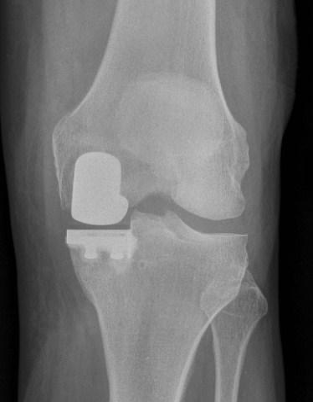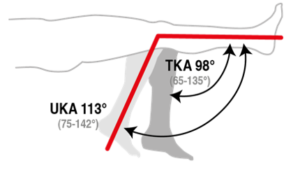Everything you want to know about unicompartmental knee replacement
What is unicompartmental knee replacement?
Unicompartmental knee arthroplasty is also called ‘unicondylar’ or ‘uni knee’ replacement. The artificial joint prothesis consists of two metal components with a plastic liner in between, that replaces the worn cartilage and bone on the inner side of the knee.
Differences between unicompartmental and total knee replacement:

Unicompartmental knee replacement only resurfaces the arthritic part of the knee where cartilage is worn, but other parts of the knee joint will stay intact. In this manner unicompartmental knee replacement retains more of the anatomy and natural function of your own knee. After unicompartmental knee replacement kneeling is often possible (although work with heavy kneeling is not advisable), and many people forget their uni knees in daily life on a regular base.
Total knee replacement replaces the whole joint with artificial material in all compartments of the lower and upper part of the knee, which affects function of crucioid ligaments and the kneecap as well. After total knee replacement deep kneeling is often quite painful or not possible at all, and TKR patients don’t forget their artificial joint in daily life very often.
Do you want to know more about the advantages and disadvantages of uni knees?
Prosthetic knee material

Unicompartmental knee replacements are made of metal, and often an alloy of cobalt-chrome or titanium is being used. In between the upper and lower leg components a plastic insert is placed, which is made of poly-ethylene. This poly-ethylene plastic is a very strong material that will only be susceptible to minimal wear with normal use.
Uni knee operation
During unicompartmental knee replacement the upper and lower part of the osteoarthritic inner compartment is replaced.
An incision of 10 to 15 centimeters is made over the worn side of the knee.
The knee part affected by osteoarthritis is resurfaced by metal components in femur and tibia, and a plastic inlay is left behind in between that functions as a shock absorber.
Video knee replacement
How long is the operation and hospital admission?
The uni knee operation takes less than 1 hour, but including preparation and recovery it will take several hours. Uni knee replacement is possible in day care surgery, but most people will stay 1 night in the hospital for observation and mobilization afterwards.
Do you want to know more about uni knee rehabilitation?
Knee replacement complications
Although unicompartmental knee replacements have low incidence of adverse events in the hands of an experienced surgeon, there are possible complications that should always be discussed beforehand just the same as with total knee replacements:
Infection;
Hematoma;
Thrombosis;
Fractures;
Loosening;
Vascular of nerve injury.
The mortality risk after unicompartmental knee replacement is significantly lower than after total knee replacement. The functional outcome has been shown to be better, and complications less frequent if performed by an experienced knee surgeon that operates more than 57 unicompartmental knees a year.
Nerve injury after knee replacement
Nerve injury is a rare complication that can occur after joint arthroplasty operations.
At the back of knee there are vital blood vessels and nerves, and injury may result in numbness of the skin or loss of power with a dropfoot. Numbness of the skin around the scar will usually improve after time, but can sometimes not lead to full recovery as well.
Recovery after uni knee replacement
Rapid recovery
The first weeks after operation a warm and painful, swollen knee can be expected but full weight bearing with crutches is allowed from the first day onwards. After the first month gradual decrease in joint reaction and improvement in function is usually seen, but mobilization should still be guided by the amount of swelling after more strenuous activity. Stretching exercises and upper leg training are very important early focus points, and rehabilitation by an experienced physiotherapist is vital.
Wound healing
De wond moet eerst goed genezen:
The incision wound should be dry within 2 weeks, at which point the skin clips or stitches can be removed.
Showering is allowed but do not soak the wound dressing within the first week.
If the dressing remains dry it can stay on the wound for 14 days.
Do not smoke to improve wound healing and to lower the risk of infection.
Knee mobilization tips & tricks
Early knee stretching exercises are important. Do not use a pillow in the back of the knee whilst lying in bed.
Adjust seat height, and early hometrainer exercises are allowed with a light gear.
Use gel packs for knee cooling. Lowering the joint temperature and swelling can improve post-operative knee pain and function.
Walking without crutches or a walker is allowed a soon as the operated knee permits to do so.
Be careful with longer walking distances or heavy deep knee bending exercises with the first couple of months.
In case of climbing stairs: use one crutch and the handle bar, and position the healthy leg up first. Going down the stairs you should position the crutch down first, and place the operated leg on the lower stairs afterwards.
Pay attention to your weight and diet. A high body mass index can cause prosthetic wear and loosening. In the early rehabilitation a high protein diet may be beneficial, but in general a low sugar and low carb diet with plenty fruit and vegetable fibers can be advised on long term.
Unicompartmental knee recovery time
Most wound pain and knee swelling can be expected within the first 2 months after unicompartmental knee surgery, but is usually experienced with much less intensity than after total knee replacement. For most people riding a bike and driving a car is possible 6-8 weeks post-operatively when crutches are no longer required. Few people still experience some knee pain during activity 6-8 months later, but the end result with regards to knee function should only be judged more than 1 year after surgery.
Flexion of the knee after knee replacement

A large proportion of patients with unicompartmental knee replacements is able to perform kneeling activities, but some discomfort can still be experienced around the kneecap during heavy loading or deep flexion. Work on the knees or peak loading of the kneecap (during long distance running for example) is not advised though due to higher risk of wear or loosening.
Normal activities in daily life such as walking, stair climbing, biking, swimming, fitness and gardening should be a realistic goal for most people after unicompartmental knee replacement. In comparison with total knee replacement approximately 10 to 15 degrees more flexion can be expected after rehabilitation of uni knee replacement.
Skin incision
Uni knee replacement can be performed through a smaller skin incision than total knee replacement. More importantly also the other muscular and soft tissue damage has been shown to be much less in comparison to total knee, which leads to lower pain scores and quicker mobilization as well.
Revison knee operation
Knee replacements sometimes require revision surgery due to loosening, instability or infection. Revision surgery is a more extensive operation and often necessitates a more intensive rehabilitation protocol. In case of revision of unicompartmental knees in many occasions a normal primary knee prothesis can still be used though.
Advantages and disadvantages of unicompartmental knee replacement
Uni knee advantages:
Better function. Most people with uni knees will reach higher functional scores in daily life and during sports with more deep flexion possibilities than total knee patients.
More ‘normal knee feeling’. After uni knee replacement higher ‘forgotten joint scores’ are experienced due to a less extensive operation with more respect to the natural knee anatomy.
Quicker operation. Unicompartmental knee surgery requires shorter operation time and has been shown to have a shorter length of stay in hospital.
Smaller scar. Uni knee replacement can be performed through a smaller skin incision with less wound pain, muscle damage and blood loss compared with total knee replacement.
Lower complication rate. Earlier mobilization is possible after unicompartmental knee replacement, with a lower mortality and complication rate if performed by an experienced uni knee surgeon.
Uni knee disadvantages:
Not always possible.Unicompartmental knee replacement may not be possible due to torn crucioid ligaments, rheumatoid arthritis, or osteoarthritic wear also in other knee compartments.
There is a learning curve for the surgeon. After more than 57 unicompartmental knee operations a year better results have been shown with less complications by more experienced uni knee surgeons.
Surgery is not without complications. Same complications are possible as during total knee replacement: e.g. infection (especially higher risk due to smoking, obesity and diabetes), deep venous thrombosis, fractures, loosening, vascular and nerve injury.
Optimal ‘Forgotten joint score’ is not possible in every patient. Unicompartmental knee surgery requires the use of artificial prosthetic materials, this will not give the exact same feeling as the natural knee felt before joint replacement.

